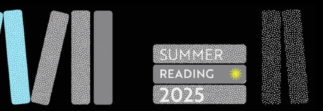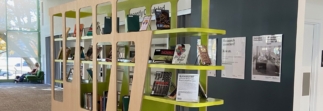In Associate Professor Stephanie Frampton’s Media in Cultural Context (21L.715) students take a journey into the history of the book, attending weekly “lab” sessions in the MIT Libraries’ Institute Archives and Special Collections (IASC), where they get to dig deep into historical books and other media. In an earlier story, we shared some of the students’ critical analyses of objects from IASC; now we’re pleased to present five more critical looks at some of the Libraries’ most intriguing materials.
Read the full entries for these and the earlier posts on the class blog.
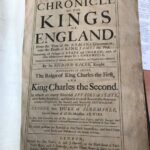 Marks of an Ancient King
Marks of an Ancient King
Alexis Drake
On a hunch, I angle one of the blank pages at the very front towards the windows. A strangely shaped watermark meets my eyes! Back before people worried about digital copyright, paper mills immersed molds with unique wire frames into a stewing vat of linen or cotton rags. The resulting paper is thinner in the places where the wires touched the pulp. Researchers today can use watermarks to date manuscripts. Although the few watermark databases I searched did not contain these two, the book revealed information about its publishing in another way.
Carefully turning past a beautiful engraving to the title page, I discover that even its title is bursting with information and would fill a paragraph of its own. Suffice to say, A Chronicle of the Kings of England… was written by Sir Richard Baker and published in 1696. Curious as to which king the chronicle begins with, I page through the tome and first find a paternal pedigree that traces the lineage of the current king (King James II) to King Egbert. Just before the actual chronicle begins, it lists all the kings – the 5th being King Arthur! You know, with the Round Table and all the knights? Read Alexis’s full analysis
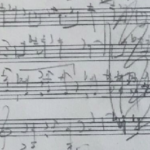 Textual Commentary in Music
Textual Commentary in Music
Jacob Martin
I confess that I’ve neglected my musical skills as a student here at MIT, but this class project posed an interesting way for me to revive them. A librarian here at the Special Collections found a manuscript by Bohuslav Martinů of a piece “Trio in D Minor” that was commissioned for the opening of Hayden Library.
The manuscript was hard to read, but I wanted to get a digital version of it. Martinů has idiosyncratic handwriting practices, as seen by an image beside of about the twenty-fourth measure. So, when a note was ambiguous, I turned to a recording MIT had of the piece’s performance at Hayden Library’s opening. I would simply listen to the recording to elucidate the manuscript wherever it was unclear. However, this also posed a problem: This was a draft. How was I to know that the notes would be the same or sufficiently similar that the recording would act as an authority? This required a closer scrutiny of the text. Read Jacob’s full analysis
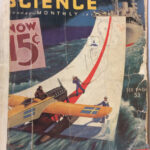 Popular Science — 1873 to Now
Popular Science — 1873 to Now
Hannah Rudoltz
I began to wonder how this bare-bones journal became the colorful magazine it is today, and learned that the publication was sold in 1915. So I looked for the first copy from 1916, but MIT did not have it. There was a gap in MIT’s collection from 1916-1933, and I was determined to find out why. MIT does have two bound volumes from 1915, but one looked to be in poor shape so I only flipped through one, which gave me no clues.
I took my search to Harvard next, but they also did not have the 1916 volume. Michael Leach, Head of Collection Development at Harvard’s Science Library, helped me search Harvard’s catalog and WorldCat. Harvard did not have any copies of the magazine from 1916 to 1921, but more interestingly neither did any other university in New England. Read Hannah’s full analysis
 Never a Dull Moment
Never a Dull Moment
Niki Tubacki
Harold ‘Doc’ Edgerton was born in 1903 in Nebraska. He attended MIT for graduate school, where he became familiar with photography and stroboscopes when he used stroboscopes to study the motion of motors and other quick-moving objects. Edgerton was very interested in teaching future generations about photography and his life experiences in general.
While he never finished or published an autobiography, he planned out sections and chapters and wrote preliminary versions of chapters. We can see in these early outlines of his book how his idea of his autobiography changed just in the months between these outlines. The second version is more condensed and basic than the first, which appeared to cover nearly every aspect of Edgerton’s life. He also included some possible titles, including “What’s up, Doc?”, “Teach Teach Teach”, “Never a Dull Moment!”, “Keep Going!”, and “Just one time more.” In these titles we get a glimpse of Edgerton’s character. Read Niki’s full analysis
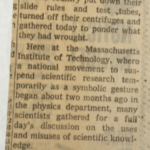 SACC Archives: Lessons for MIT Activists Today
SACC Archives: Lessons for MIT Activists Today
Jessica Adams
As someone with a strong interest in the history of activism and involvement with activism on MIT’s campus, choosing my project for Media in Cultural Context was easy: there is a huge archive of one of MIT’s student activist groups, the Science Action Coordinating Committee (SACC), which mobilized in 1968 in response to military research on MIT’s campus and the Vietnam War. As my research on SACC progressed, I realized that much of the conclusions I had drawn could be of use for activists on MIT’s campus today.
Perhaps my most encouraging finding was that MIT students draw disproportionate press attention simply by being MIT students. The most striking case of this occurred when SACC proposed its first action, a campus-wide voluntary research stoppage to take place on March 4, 1969, and received extensive coverage in the Boston Globe, the New York Times and other nationwide publications. Further, when this tactic was reported at MIT, it quickly caught on at other universities across the nation, making March 4 a nationwide event to raise awareness of Department of Defense funding for potentially harmful military research on campus. Read Jessica’s full analysis
